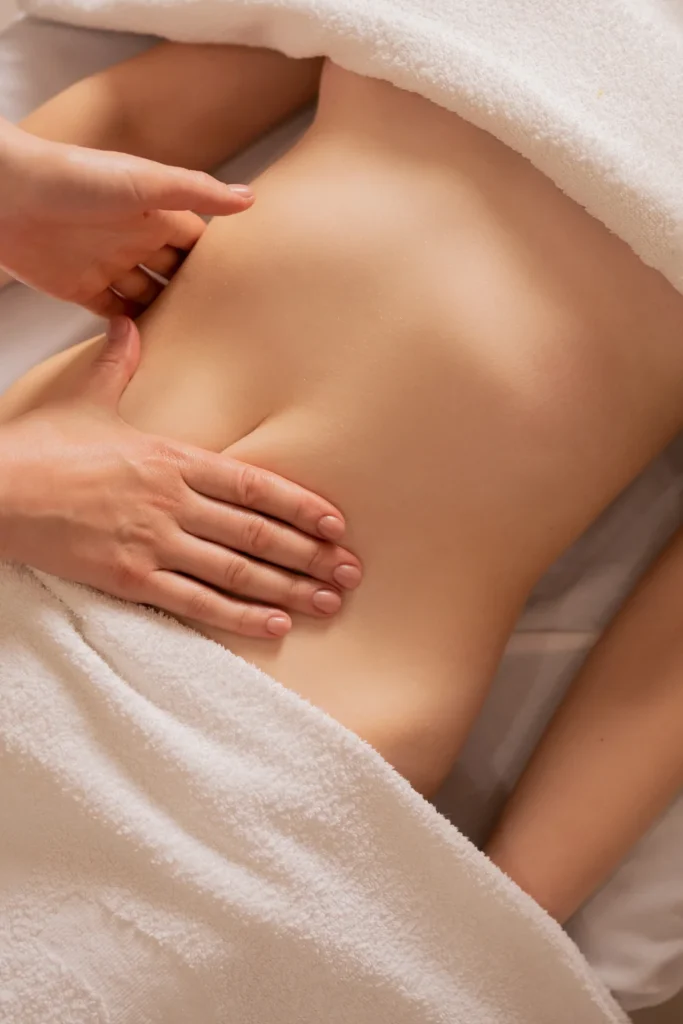Do you feel like you have swelling in your abdominal area after your tummy tuck or abdominoplasty?
Post-op swelling is your body’s natural response to surgical changes and is a sign that your body is working hard to repair itself and rebuild your strength.
Every patient experiences it differently, however, proper care can help reduce post-op swelling and speed up your recovery timeline.
Let’s discuss the best strategies on how to reduce swelling after tummy tuck so you can feel and look your best as quickly as possible.
Dr. Adrian Lo can help you achieve the best version of yourself with a personalized plan for your procedure. Find out if a tummy tuck is right for you, and explore all the need-to-know facts about tummy tuck or abdominoplasty. Contact us to schedule a consultation.
Understanding Post-Op Swelling

The human body responds to surgical intervention through an inflammatory response.
When you undergo abdominoplasty, most commonly known as “tummy tuck”, your body immediately mobilizes an army of healing cells, creating temporary swelling as part of its natural repair mechanism. This process is not a setback but a biological response designed to protect and restore your tissues.
While swelling is inevitable, there are still proven techniques on how to reduce swelling after a tummy tuck that patients could perform for a faster recovery.
When does swelling peak? Swelling typically occurs within the first 72 hours post-surgery. Patients can expect a significant reduction in swelling within 4 to 6 weeks, with continued improvements occurring for several months. The recovery timeline is different for everyone, and it is important to understand the tummy tuck healing stages to set realistic expectations reducing anxiety about the healing process.
Related: Abdominal Liposuction vs Tummy Tuck: What’s the Difference?
Diet and Hydration
A balanced diet rich in anti-inflammatory foods is helpful to reduce post-op swelling and support overall healing. Incorporate a variety of colorful vegetables, lean proteins, and whole grains to enhance nutrient intake and aid tissue repair.
Additionally, stay well-hydrated! Consider electrolyte-rich beverages to optimize hydration and support healthy fluid balance as your body heals.
Anti-Inflammatory Foods
One of the most effective methods on how to reduce swelling after tummy tuck is paying attention to your food intake. Consider incorporating foods rich in omega-3 fatty acids, such as wild-caught salmon, chia seeds, and walnuts, in your diet. These nutritional powerhouses help modulate inflammatory responses and accelerate tissue repair.
Additional recommended anti-inflammatory foods include:
- Turmeric
- Ginger
- Berries
- Dark leafy greens
- Green tea
- Bone broth
Hydration Requirements
Hydration supports cellular repair, helps manage inflammation, and facilitates lymphatic drainage. Aim for at least 8-10 glasses of water daily, adjusting based on individual body weight and activity level.
Make it a habit to track your water intake. Consider using a marked water bottle or smartphone applications that monitor daily water consumption. Other than water, herbal teas and water-rich fruits can also supplement your hydration strategy.
Sodium Restrictions
Sodium directly influences fluid retention and post-surgical swelling. High sodium intake can exacerbate inflammation and prolong edema. Limit your sodium intake to 1,500-2,300 milligrams daily, especially during the initial recovery phase.
Practical sodium reduction strategies include the following:
- Reading nutrition labels
- Avoiding processed foods
- Using herbs instead of salt for flavoring
- Choosing fresh ingredients over packaged alternatives
Supplement Recommendations
Targeted supplementation can speed up healing when approached methodically. Recommended supplements include:
- Vitamin C for collagen production
- Bromelain to reduce inflammation
- Arnica for bruising
- Zinc for wound healing
Always consult your plastic surgeon before beginning any supplement regimen to ensure compatibility with your specific surgical recovery plan.
Related: Why You Might Still Have a Lower Belly Pooch After Tummy Tuck
Lymphatic Drainage Techniques

Lymphatic drainage is one of the key strategies in how to reduce swelling after tummy tuck procedures.
Lymphatic massage after tummy tuck promotes healing and reduces inflammation. This specialized massage technique helps redirect accumulated fluid, reduces swelling, and supports the body’s natural healing mechanisms.
Manual Drainage Methods
Begin gentle self-massage techniques around two weeks after your tummy tuck, following approval from your plastic surgeon.
Focus on light, directional strokes toward lymph nodes to promote lymphatic circulation and reduce swelling, ensuring a supportive touch rather than aggressive pressure. While self-massage can be beneficial, consider seeking professional help for more targeted treatments that align with your unique recovery needs.
Professional Massage Benefits
Professional lymphatic massage offers precision and expertise that self-massage cannot replicate. Trained therapists understand anatomical nuances and can provide targeted treatment aligned with surgical recovery protocols.
Timing and Frequency
Initiate lymphatic drainage techniques approximately 2 to 4 weeks post-surgery or upon receiving approval from your plastic surgeon. Initial sessions should be brief and gentle, gradually increasing duration and intensity as healing progresses.
Related: Types of Tummy Tucks: Your Guide to an Informed Decision
Exercise and Movement Guidelines
Walking Schedule
Incorporating regular walking into your routine improves circulation and helps to prevent stiffness in the surgical area. Gradually increasing the duration and intensity allows your body to adapt, supporting a smoother recovery process while ensuring safety and comfort.
- Days 1-3: Short indoor walks
- Week 1-2: Gentle, slower-paced walking
- Week 3-4: Moderate walking, increasing duration
Core Engagement Tips
Proper post-tummy tuck compression is an essential step in managing swelling and encouraging a smooth recovery.
While protecting your surgical site, you can also work on maintaining your muscle tone with light core engagement. Gentle and controlled breathing exercises are a safe way to activate your abdominal muscles without causing discomfort. These exercises help build core strength and improve blood circulation, which can help heal your body and reduce the risk of complications as you recover.
Progressive Activity Plan
Start with a structured plan for increasing activity, beginning with gentle, slow-paced walks within the first few days after surgery. Gradually progress to longer walks and light core engagements as you heal, while avoiding high-impact activities for at least six weeks for optimal recovery.
Stay attentive in observing your body’s signals and always follow your surgeon’s guidance to ensure a safe return to full mobility.
Exercise Restrictions
Avoid high-impact activities, heavy lifting, and intense core exercises for at least 8 weeks.
Your plastic surgeon will provide personalized guidance based on your individual healing progress. These restrictions give your body the necessary time to maximize your healing to give you the best result possible.
Red Flags to Watch For

While recovery is typically smooth, it is still important to be aware of potential complications. By staying alert for any unusual signs or symptoms, you will be able to act quickly, ensuring a successful recovery and avoiding health risks.
Excessive Swelling Signs
This guide on how to reduce swelling after tummy tuck is only helpful when the swelling is still within the range of what is normally expected. Identifying excessive swelling signs early can help you seek timely medical advice, ensuring any complications are addressed before they escalate. This includes:
- Asymmetrical swelling
- Hardened tissue
- Significant increase in pain
- Unexpected changes in surgical site appearance
Pain Level Indicators
It is important to differentiate between normal post-surgical discomfort and indications of complications.
Mild to moderate pain can typically be controlled with prescribed medications. However, any persistent or worsening pain, particularly if accompanied by redness, swelling, fever, or unusual discharge, should be brought to your plastic surgeon’s attention.
Staying attentive and listening to your body helps ensure your recovery is smooth and free from any complications.
Temperature Changes
Managing temperature fluctuations can help alleviate discomfort and promote healing after surgery.
Incorporate cold or warm therapy as directed by your plastic surgeon to manage swelling and aid recovery. This approach helps soothe the surgical area, enhances circulation, and reduces the risk of complications.
Drainage Concerns
Your plastic surgeon will explain everything you need to know about tummy-tuck drainage to keep fluid buildup under control. Recognize what constitutes normal drainage and be aware of red flags such as increased discomfort, swelling or increased drainage from the surgical area.
Related: A Patient’s Guide to Diastasis Recti and Tummy Tuck
Schedule a Consultation with Dr. Adrian Lo
Picture yourself finally achieving the body you have always dreamed of! With Dr. Adrian Lo’s compassionate, personalized care, your unique needs are prioritized every step of the way. Our patients from Philadelphia and New Jersey trust Dr. Lo’s expertise and patient-centered approach for safe surgeries and a smooth recovery process.
Curious to see the amazing results others have achieved? Explore our tummy tuck before-and-after gallery for real-life transformations! Feel supported, informed, and confident at every stage – schedule your consultation and take the leap toward your best self!
